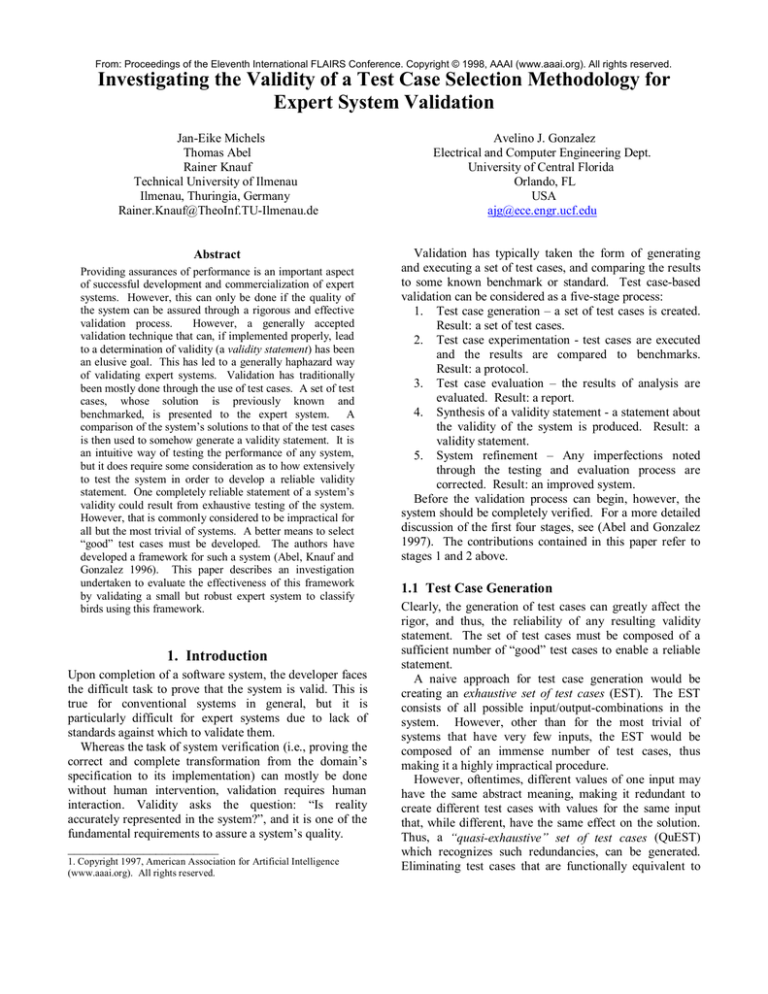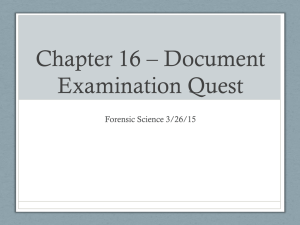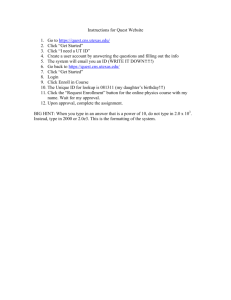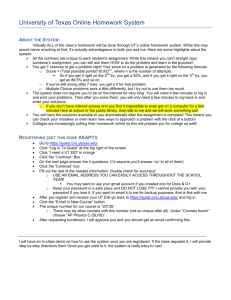
From: Proceedings of the Eleventh International FLAIRS Conference. Copyright © 1998, AAAI (www.aaai.org). All rights reserved.
Investigating the Validity of a Test Case Selection Methodology for
Expert System Validation
Jan-Eike Michels
Thomas Abel
Rainer Knauf
Technical University of Ilmenau
Ilmenau, Thuringia, Germany
Rainer.Knauf@TheoInf.TU-Ilmenau.de
Abstract
Providing assurances of performance is an important aspect
of successful development and commercialization of expert
systems. However, this can only be done if the quality of
the system can be assured through a rigorous and effective
validation process.
However, a generally accepted
validation technique that can, if implemented properly, lead
to a determination of validity (a validity statement) has been
an elusive goal. This has led to a generally haphazard way
of validating expert systems. Validation has traditionally
been mostly done through the use of test cases. A set of test
cases, whose solution is previously known and
benchmarked, is presented to the expert system. A
comparison of the system’s solutions to that of the test cases
is then used to somehow generate a validity statement. It is
an intuitive way of testing the performance of any system,
but it does require some consideration as to how extensively
to test the system in order to develop a reliable validity
statement. One completely reliable statement of a system’s
validity could result from exhaustive testing of the system.
However, that is commonly considered to be impractical for
all but the most trivial of systems. A better means to select
“good” test cases must be developed. The authors have
developed a framework for such a system (Abel, Knauf and
Gonzalez 1996). This paper describes an investigation
undertaken to evaluate the effectiveness of this framework
by validating a small but robust expert system to classify
birds using this framework.
1. Introduction
Upon completion of a software system, the developer faces
the difficult task to prove that the system is valid. This is
true for conventional systems in general, but it is
particularly difficult for expert systems due to lack of
standards against which to validate them.
Whereas the task of system verification (i.e., proving the
correct and complete transformation from the domain’s
specification to its implementation) can mostly be done
without human intervention, validation requires human
interaction. Validity asks the question: “Is reality
accurately represented in the system?”, and it is one of the
fundamental requirements to assure a system’s quality.
________________________
1. Copyright 1997, American Association for Artificial Intelligence
(www.aaai.org). All rights reserved.
Avelino J. Gonzalez
Electrical and Computer Engineering Dept.
University of Central Florida
Orlando, FL
USA
ajg@ece.engr.ucf.edu
Validation has typically taken the form of generating
and executing a set of test cases, and comparing the results
to some known benchmark or standard. Test case-based
validation can be considered as a five-stage process:
1. Test case generation – a set of test cases is created.
Result: a set of test cases.
2. Test case experimentation - test cases are executed
and the results are compared to benchmarks.
Result: a protocol.
3. Test case evaluation – the results of analysis are
evaluated. Result: a report.
4. Synthesis of a validity statement - a statement about
the validity of the system is produced. Result: a
validity statement.
5. System refinement – Any imperfections noted
through the testing and evaluation process are
corrected. Result: an improved system.
Before the validation process can begin, however, the
system should be completely verified. For a more detailed
discussion of the first four stages, see (Abel and Gonzalez
1997). The contributions contained in this paper refer to
stages 1 and 2 above.
1.1 Test Case Generation
Clearly, the generation of test cases can greatly affect the
rigor, and thus, the reliability of any resulting validity
statement. The set of test cases must be composed of a
sufficient number of “good” test cases to enable a reliable
statement.
A naive approach for test case generation would be
creating an exhaustive set of test cases (EST). The EST
consists of all possible input/output-combinations in the
system. However, other than for the most trivial of
systems that have very few inputs, the EST would be
composed of an immense number of test cases, thus
making it a highly impractical procedure.
However, oftentimes, different values of one input may
have the same abstract meaning, making it redundant to
create different test cases with values for the same input
that, while different, have the same effect on the solution.
Thus, a “quasi-exhaustive” set of test cases (QuEST)
which recognizes such redundancies, can be generated.
Eliminating test cases that are functionally equivalent to
other test cases and subsumed by these accomplishes this.
This reduction is domain- and representation-dependent
and has to be carried out using only reliable, proven
knowledge and known restrictions of the domain and its
representation. The QuEST can be significantly smaller in
cardinality that the EST, thus making it more practical for
use. By definition, a set of test cases is quasi-exhaustive if
the execution of this set leads to the same results as would
the execution of the EST. See (Herrmann, Jantke and
Knauf, 1997) and (Abel, Knauf and Gonzalez 1996] for
more details about the QuEST. The advantages of the
QuEST are that it is functionally equivalent to the EST, but
significantly smaller. Nevertheless, for some systems, the
QuEST can still be excessively large.
One way to further reduce the set of test cases beyond
the QuEST is to rigorously test the portions of the system
that have a high priority, while less so those that have a
lesser priority. The priority of a portion of a system can be
based on certain user- or developer-defined criteria.
Priority of a portion of the system can be defined to mean
the cost of an error (financial, in human lives, etc.) in this
particular group of rules. A set of test cases derived on the
basis of such criteria is called a “reasonable” set of test
cases (ReST).
In the test case selection stage for the ReST, different
kinds of criteria (e.g., domain-related criteria, outputrelated criteria) are used to select the most relevant test
cases to investigate a system’s validity. See (Abel and
Gonzalez 1997] for more details on this topic.
While the sets of test cases described above may sound
conceptually valid as well as desirable, the question
remains whether their use can lead to a reliable validity
statement. Before answering that question, however, it
remains to be seen whether they can be used to
successfully detect errors that may exist in a rule base. Of
particular interest is the determination of whether the
QuEST is in fact functionally equivalent to the EST. The
intent of the investigation described in this paper is to
answer this last question.
1.2 Objectives of this Research
The objective of this research project is to test the
procedures used in the first and second stages of the
validation process briefly described in the introduction.
More specifically, this work puts into practice the
concepts of the QuEST, and empirically determines their
validity by applying them to a small but non-trivial expert
system.
The basic idea behind this work was to determine
whether errors artificially seeded into the selected test bed
expert system would be detected by the test cases included
in the QuEST. It was assumed that these errors would be
detected by the EST due to its exhaustive nature, as it
would have been highly impractical to actually generate,
test and evaluate the very large EST for this system.
By detection, it is meant that a test case executed by the
expert system provided a solution/answer which did not
agree with that of a human expert exposed to the same set
of inputs. No attempts were made to determine just how
different the answers were. Rather, the existence of a
difference in answer was noted. If a test case in the
QuEST produced an answer different from that of an
expert as a result of the seeded error, then this error was
deemed to be detected by the QuEST.
2. Test Bed Expert System
Several expert systems of between 50 and 100 rules were
evaluated for use as the test bed for this project. The one
chosen was called The Ornithologist; written by Mr. Steve
Bruce, a Master’s student at the University of Central
Florida. The Ornithologist was developed with Personal
Consultant Plus (PC Plus), an expert system shell
originally developed by Texas Instruments. Its purpose is
to identify birds that can be observed in Florida. It was
designed for bird watching and is, therefore, of a lighter
character than, for example, a diagnostic system for power
plants. Nevertheless, it has many similarities to more
ambitious systems.
The Ornithologist identifies 65
different birds, each of which belongs to one of the
following species: water birds, ducks, shore birds, prey
birds, land birds, insect eaters or seed eaters.
2.1 The Knowledge Base
The XPS uses a backward chaining reasoning technique to
make a decision. Its knowledge base consists of 71 rules.
Sixty-five of these produce final outputs, whereas the other
six are intermediate rules that are used by some of the final
hypotheses (conclusions). Each rule in the system that
represents a hypothesis has a confidence factor of 100%.
The Ornithologist uses up to fourteen different inputs, but
it does not need all of them at all times. Nevertheless, at
least two inputs are always necessary to identify a bird.
The inputs are called parameters in the nomenclature of the
system. A typical rule looks like this:
IF (SIZE > 17 AND SIZE < 24 AND WINTER-B AND
BILL-G AND AB-DUCK)
THEN (SPECIES = American Black Duck, Anas
rubripes)
This rule will fire if the value for the parameter ‘SIZE’ is
both greater than 17 and less than 24 (inches), the
intermediate hypothesis ‘WINTER-B’ is satisfied, and the
values for both parameters BILL-G and AB-DUCK are
‘true’. The final output is then a value for the parameter
‘SPECIES’ which is this time ‘American Black Duck,
Anas rubripes’.
2.2 Problems with the Ornithologist
It was initially assumed that the Ornithologist was correct
and valid as taken from its author. However, during the
examination of the Ornithologist, some problems could be
found within it. These problems had to be solved, before
the investigation could be started.
The Ornithologist was designed such that it is possible
for a bird to have more than one different bill shape at the
same time. This, of course, is not realistic. The author of
the system stated that this was not the intended effect.
Thus, the system was treated as if only one bill shape was
possible as input.
The author of the system also indicated that he had
intended to show the user a scanned picture of the bird as
the last question. However, due to time constraints, this
was not possible for him to do. That is the reason why the
‘last question’ describes the bird nearly as if you see it on a
picture. Here, it is again theoretically possible to answer
two different last questions at the same time with ‘yes’.
But this doesn’t make any sense from a practical
standpoint, since a bird could not have two totally different
appearances. Therefore, whenever a last question is
answered with ‘yes’, all other last questions are
automatically answered with ‘no’.
Furthermore, the Ornithologist contained one
intermediate rule that was not used by any other rule.
Therefore, it could be omitted from the system. Later, it
was re-introduced as a modification of the original system.
Another problem existed in that in rule 46, the input
sensor BELOW is compared to the value ‘white’. Since
‘white’ is not a legal value for this sensor, this rule never
fired. The correct value in this rule should be ‘whitish’.
This error was fixed (i.e., ‘white’ was replaced by ‘whitish’
in the rule).
Another error lies within the tool PC Plus. Although rule
23 was in the knowledge base, it never fired, even when its
premise was satisfied. After the same knowledge base was
saved without a modification and the expert system was
started again, the rule fired. Nevertheless, rule 23 is
considered as part of the knowledge base.
3. Empirical Evaluation Procedure
One problem immediately faced was the lack of access to a
human expert to assist with the validation process of the
QuEST. This was needed in order to determine whether
the test case answers were correct or not. To overcome
this problem, the original system (as corrected above) was
treated as the expert whose answers were always correct.
Additionally, errors were seeded into copies of the original
system to see whether the test cases that composed the
QuEST and the ReST were able to detect them. The test
cases were presented both to the faulty system as well as to
the original. Differences in their responses were indicative
of an error in the faulty version. The work was composed
of the following steps:
• Generate the QuEST for the original Ornithologist.
• Derive faulty versions of the Ornithologist by
seeding errors into copies of the original system.
• Generate the QuEST’s for these faulty systems.
• Use these QuESTs as test cases for the original
system as well as for the faulty derived systems.
• Observe if any conclusion could be drawn from the
different outputs of the original and the faulty
systems.
• Generate the ReST for all systems.
• Observe which errors could still be detected. The
observations made are the basis for this paper.
The last 2 steps, those dealing with the ReST are not
discussed in this paper.
3.1 The Exhaustive Set of Test Cases (EST)
An exhaustive set of test cases for The Ornithologist
consists of all possible combinations of system inputs and
the related final outputs. To the outputs belong not only
the 65 birds the system can identify, but also an extra
output, when there is no rule that can fire for a given input
combination: ‘The XPS was unable to make any
conclusions’.
As mentioned previously, the Ornithologist uses up to
14 different input dimensions.
Although not all
dimensions are used at all times, one rule exists that uses
seven different input dimensions to identify a bird (i.e.,
rule 56). On the other hand, another rule (rule 42) only
needs two inputs in order to identify the bird correctly. In
general, most of the rules need five or six different inputs.
Although a specific input dimension is not needed for a
certain rule in order to identify a bird, it is possible that the
system requires a value for that dimension. Because of
this, it makes sense that a test case has defined values (i.e.,
values that are accepted by the system as an input) for all
fourteen input dimensions, before it is presented to the
system, even though, these inputs might not all be needed.
The next issue is how many possible values each input
dimension can legally accept. An in-depth discussion of
this is found in (Michels 1998). However, in summary, the
total amount of all possible combinations of all fourteen
input dimensions is 541 * 2 * 2 * 2 * 2 * 2 * 2 * 2 * 2 * 12
* 13 * 5 * 5 * 65 = 35,108,736,000.
From the above number, it is obviously not practically
feasible to have an exhaustive set of test cases (more than
35 billion test cases). There has to be a way to reduce this
very large number to one that can be adequately handled.
The QuEST is an attempt to do just this.
3.2 Errors Seeded
A total of 12 errors were seeded in rules that affect
intermediate hypotheses, and an additional 24 were seeded
in rules that affect final conclusions. Space limitations
preclude a detailed discussion of these errors. However,
these errors generally consisted of altering the premise of a
rule by adding, deleting or modifying a premise pattern,
adding a new rule or leaving out an existing rule. Only one
error was seeded at a time. All these represented
differences from the original system, and thus were
considered faults. The errors were labeled as Mod1
through Mod35, where, of course, Mod stands for
modification. Each mod represents one error seeded into
an otherwise correct version of the Ornithologist system.
Additionally, some of the modifications contained a slight
variation, and these were labeled with an “a” next to the
number. These modifications are completely described in
(Michels 1998).
The definition of the QuEST is that it is functionally
equivalent to the EST, so that theoretically, it must detect
ALL errors in the knowledge base.
Whenever the original Ornithologist and the altered
version differed in an output for the same test case input,
the output of the original was treated as correct while the
output of the other was considered to be incorrect.
Whenever such a discrepancy occurred, the test case was
inspected to determine whether the discrepancy came
about as a result of the seeded error.
As a result of this investigation, it was discovered that
the set P0 assumes an important role in the validation
process. This will be explained below.
3.4 Errors in Intermediate and Final Hypotheses
3.3 The Quasi-Exhaustive Set of Test Cases
The approach of how to generate such a QuEST is
described in detail in (Abel, Knauf and Gonzalez 1996).
Below is a summarization of this procedure:
1. Break down the range of an input into sub-ranges
where its values are considered to be equivalent in
terms of its effects on the final conclusions,
2. Compute an initial set of potential test cases, P, based
upon combinations of values within these sub ranges,
3. Sort these cases into several sets Pi having very
distinctive features, and,
4. Filter all Pi by eliminating those that are subsumed by
others.
The QuEST is the union of all sets of positive test cases
that imply certain hypotheses. The set of negative test
cases is called P0. A ‘negative test case’ is one whose
inputs are such that the hypothesis that it is designed to
conclude is not positively concluded. For example, if a
rule is intended to detect a faulty component, a negative
test case for that conclusion is one whose input values do
not conclude that the component is faulty.
A tool called TC-Gen was used to generate the QuEST
automatically using the technique described in (Abel,
Knauf and Gonzalez 1996]. TC-Gen uses the structure of
the rule base and the legal values of the inputs to determine
the meaningful test cases.
If one conclusion or
intermediate hypothesis does not make use of one
particular input, it simply uses that input’s declared default
value. This is an artificial means of allowing all the test
cases to have equally sized input vectors. The default
values are determined by TC-Gen, and not by the expert
system or its developer.
The QuEST for the Ornithologist (original) consisted of
317 test cases and the set P0 of 1063 test cases. Compared
to the 35,108,736,000 test cases in the EST, the 1480 test
cases of both the QuEST and P0 represent a significant a
huge reduction.
One of the goals of this investigation was to determine
whether the QuEST generated by the TC-Gen is really
quasi-exhaustive. That is, does the QuEST contain test
cases that will detect an error in an XPS if there is one?
An error in an intermediate hypothesis had more
consequences on the QuEST than did an error in a final
hypothesis. This is because an intermediate hypothesis
was used by one or more final hypotheses. However, if
one intermediate hypothesis was only used by one other
final hypothesis, then this intermediate hypothesis could
also be the source of the error (as it happened with the
alterations Mod 4a, Mod 5a and Mod 6a).
3.4.1 Detected Errors. The errors in alterations Mod 1 to
Mod 8, which introduced errors in rules affecting the
intermediate hypotheses, were all detected. This means
that there existed test cases in the QuEST that indicated an
anomaly. Nevertheless, an anomaly in the process was
discovered. There were two final hypotheses for which no
test case existed that identified errors.
This was
interesting, since these final hypotheses used rules that
made use of the erroneous intermediate hypothesis. The
expectation would have been that since the intermediate
hypothesis was incorrect, the final conclusion would also
be incorrect. The answer was that these rules used a
negation of the intermediate hypothesis in their premises.
Since the error seeded caused the affected intermediate
hypothesis to be not true for different values than
originally planned, this was not readily apparent from the
cases in the QuEST. One reason it was discovered is that
there were several other final conclusions that used this
hypothesis, and not as a negation. What would have
happened, however, if there was only one final conclusion
that would employ an hypothesis, and that would be as a
negation? In order to further investigate this question, the
alterations to modifications Mod4, Mod5 and Mod6 were
made, resulting in Mod4a, Mod5a, and Mod6a. These
seeded errors in intermediate rules whose hypotheses are
only used by one other final conclusion as a negation.
Theoretically, it would have been found if an EST were
employed. Inclusion of the test cases in P0, however,
would remedy this discrepancy.
In the errors affecting the final conclusions, alterations
Mod 11 to Mod 13, Mod 17 to Mod 19, Mod 21 to Mod
24, Mod 26 to Mod 32, Mod 34 and Mod 35 all were
detected appropriately. That leaves several errors that
went undetected. These are discussed below:
3.4.2 Undetected Errors. There were several errors that
went undetected. This section will attempt to explain why
this happened.
Mod14, 15, 16 and 20 had a similar situation as in
Mod4a, 5a, and 6a. This is because while all positive test
cases in the original are also positive in the modified
system, such is not the case for the negative test cases.
Once again, this would be resolved by making use of the
cases in P0.
Nevertheless, there were three errors not detected by
either the QuEST or P0. These represent potentially more
serious situations.
Mod9 represents an intermediate hypothesis that was
added to the rule base. This hypothesis is not used by any
other rule, so the TC-Gen tool treated it as a final
hypothesis, and it generated test cases as if it were in fact
able to identify birds. Since it is not, it used all the default
values for the rules, and neither the original system, nor the
modified one knew of any bird that is described by all the
default values. Thus, the original system and the faulty
one agreed in that these inputs identify no bird, i.e., “The
system was not able to make any conclusions”. The
question that remains is whether this type of error is
realistic, and whether it should have been detected as an
incomplete element of the knowledge base during the
verification process.
Mod33 removes a rule from the rule base. Since the
methodology for developing the QuEST uses the systems
own rule base structure to generate the test cases, it cannot
detect an error by omission. Thus, such errors are not
detectable by using the QuEST or P0.
Mod25, the last remaining unexplained undetected error
results from the deletion of a pattern in a rule’s premise
that references an input dimension. Since TC-Gen puts the
default value in the test case input vector if the input is not
being used by the test case, if the default value happens to
agree with the value of the input had the input been used,
the error will not be detected. This is exactly what
happened in Mod25. Of course, this could be solved by
changing the way in which TC-Gen generates the test
cases.
4. Summary and Conclusion
This investigation provided an opportunity to implement
the concept of a Quasi-exhaustive set of test cases, and to
evaluate whether it is in reality equivalent to the exhaustive
set of test cases. An expert system consisting of 71 rules
called the Ornithologist was used as the test bed. It was
modified several times, each version introducing one and
only one error. There were several types of errors
introduced. Then the QuEST for the modified version was
generated. These test cases were presented to the original
system as well as to the modified version to look for
differences between their solutions. If there were any
differences, and the difference could be traced to the
seeded error, then it was determined that the QuEST was
successful in detecting that error. If an error produced no
differences in output for all the test cases in the QuEST,
then that error was said to be undetected. Errors in rules
that lead to intermediate hypotheses as well as to final
conclusions were included.
In all, 36 errors were
introduced.
Of the 36 errors introduced, 10 went undetected.
However, a closer examination of the cause of the
undetected errors provided a valuable insight into the
workings of expert systems. Furthermore, 9 of the 10
undetected errors could be easily detected by making some
rather simple changes to the QuEST generation procedure.
The last one represented an error of omission, and
therefore not detectable. However, it is doubtful that the
EST would also be able to detect such errors of omission.
The effect of that is that the number of test cases in the
QuEST is increase somewhat as a result of including the
set P0 as part of the QuEST. This leaves it up to the ReST
to further reduce the cardinality of the test case set to a
point that it is practical.
Thirty-six cases do not represent a large number of
errors n order to declare success or failure. However, these
cases represent the different types of errors that could exist
in an expert system. Therefore, the authors consider the
QuEST to be in fact functionally equivalent to the EST if
the recommendations included herein are implemented.
Further research in this topic, of course, centers on the
ReST, and how to reduce that number.
5. References
Abel, T., Gonzalez, A. J., 1997, “Utilizing Criteria to
Reduce a Set of Test Cases for Expert System Validation”,
Proceedings of the Tenth Florida Artificial Intelligence
Research Symposium (FLAIRS-97), Daytona Beach, FL.,
USA, pp. 402-406.
Abel, T., Knauf, R., Gonzalez, A. J., 1996, “Generation
of a Minimal Set of Test Cases that is Functionally
Equivalent to an Exhaustive Set, for Use in KnowledgeBased System Validation”, Proceedings of the Ninth
Florida Artificial Intelligence Research Symposium
(FLAIRS’96), Key West, FL., USA, pp. 280 - 284.
Herrmann, J., Jantke, K. P., Knauf, R., 1997, “Towards
Using Structural Knowledge for System Validation”,
Technical
Report
Meme-IMP-2/1997,
Hokkaido
University Sapporo,
Meme
Media
Laboratory,
February/March 1997.
Michels, J. E., 1998, “Validating a Validation Tool –
Experiences with a Test Case Providing Strategy”,
Undergraduate Practicum, Technical University of Ilmenau
and University of Central Florida, January 1998.








